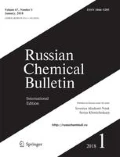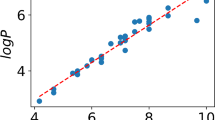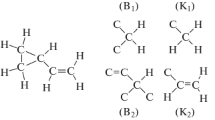Abstract
An efficient structure filtration method for the operation with chemical databases containing information on the structures and properties of organic molecules was proposed. The technique involves the use of electronegativity indices for generation of identification keys and for isomorphism tests of the molecular graphs corresponding to the structural formulas. The test set for the method proposed included a total of 95,000,000 molecules containing up to sixty carbon atoms. Tests revealed a high discriminating capability of the electronegativity indices and high efficiency of the method for solving both general problems (recognition of chemical structures, chemical database management systems) and specific tasks (generation of molecular graphs, etc.) in chemical informatics.
Similar content being viewed by others
References
N. S. Zefirov, M. A. Kirpichenok, F. F. Izmailov, and M. I. Trofimov, Dokl. Akad. Nauk SSSR, 1987, 296, 883 [Dokl. Chem., 1987 (Engl. Transl.)].
M. I. Trofimov and E. A. Smolenskii, Izv. Akad. Nauk. Ser. Khim., 2000, 401 [Russ. Chem. Bull., Int. Ed., 2000, 49, 402].
R. T. Sanderson, Chemical Bonds and Bond Energy, Acad. Press, New York, 1976, 218 pp.
N. S. Zefirov, M. A. Kirpichenok, and M. I. Trofimov, Dokl. Akad. Nauk SSSR, 1989, 304, 887 [Dokl. Chem., 1989 (Engl. Transl.)].
M. R. Nelson, Dr. Dobb’s J., May, 1992.
A. B. Prolubnikov and R. T. Faizulin, Matematicheskie struktury i modelirovanie [Mathematical Structures and Modelling], Omsk, Omsk Gos. Univ., 2002, Issue 9, 1 (in Russian).
A. B. Prolubnikov and R. T. Faizulin, Matematicheskie struktury i modelirovanie [Mathematical Structures and Modelling], Omsk, Omsk Gos. Univ., 2003, Issue 11, 28 (in Russian).
D. G. Corneil and C. C. Gotlieb, J. ACM, 1970, 17, 51.
R. C. Read and D. G. Corneil, J. Graph Theory, 1977, 1, 339.
G. Gati, J. Graph Theory, 1979, 3, 95.
M. Meringer, J. Graph Theory, 1999, 30, 137.
F. Harary, Graph Theory, Addison-Wesley, Massachusetts, 1969].
A. Kerber, R. Laue, T. Grüner, and M. Meringer, MATCH, 1998, 37, 205.
B. D. McKay, Congressus Numerantium, 1981, 30, 45.
I. A. Faradzhev, in Algoritmicheskie issledovaniya v kombinatorike [Algorithmic Studies in Combinatorics], Nauka, Moscow, 1978, 3 (in Russian).
MATCH, 1992, 27.
MATCH, 1998, 37.
M. S. Molchanova, V. V. Shcherbukhin, and N. S. Zefirov, J. Chem. Inf. Comput. Sci., 1996, 36, 888.
D. Bonchev, O. Mekenyan, and N. Trinajstic’, J. Comp. Chem., 1981, 2, 127.
M. I. Trofimov, J. Math. Chem., 1991, 8, 327.
W. Lipski, Kombinatoryka dla Programistow, Wydawnictwa Naukowo-Techniczne, Warzawa, 1982.
S. S. Tratch, M. I. Stankevitch, and N. S. Zefirov, J. Comp. Chem., 1990, 11, 899.
R. Sedgewick, Algorithms in C. Part 5. Graph Algorithms, 3rd ed., Addison-Wesley, Boston, 2003.
E. A. Smolenskii, Dokl. Akad. Nauk, 2001, 380, 60 [Dokl. Chem., 2001 (Engl. Transl.)].
E. A. Smolenskii, Zh. Vychisl. Matem. Matem. Fiz. [J. Comput. Math. Math. Phys.], 1962, 2, 371 (in Russian).
V. J. Rayward-Smith, A First Course in Formal Language Theory, Blackwell Scientific Publications, Oxford, 1983.
I. N. Bronshtein and K. A. Semendyaev, Spravochnik po matematike dlya inzhenerov i uchashchikhsya vuzov [Handbook of Mathematics for Engineers and Students], 13th ed., Nauka, Moscow, 1986, 492, 493 (in Russian).
A. A. Zykov, Osnovy teorii grafov [Fundamentals of Graph Theory], Vuz. Kniga, Moscow, 2004, 9 (in Russian).
M. I. Nechepurenko, V. K. Popkov, S. M. Mainagashev, S. B. Kaul’, V. A. Proskuryakov, V. A. Kokhov, and A. B. Gryzunov, Algoritmy i programmy resheniya zadach na grafakh i setyakh [Algorithms and Programs for Solving Problems on Graphs and Networks], Nauka, Novosibirsk, 1990, 16 (in Russian).
D. E. Knuth, The Art of Computer Programming, 1, Fundamental Algorithms, Addison-Wesley, Massachusetts, 1968.
V. N. Kas’yanov and V. A. Evstigneev, Grafy v programmirovanii: obrabotka, vizualizatsiya i primenenie [Graphs in Programming: Processing, Visualization, and Applications], BHV-Petersburg, St.-Petersburgh, 2003, 1015 (in Russian).
Author information
Authors and Affiliations
Additional information
Dedicated to Academician N. S. Zefirov on the occasion of his 70th birthday.
Published in Russian in Izvestiya Akademii Nauk. Seriya Khimicheskaya, No. 9, pp. 2166–2176, September, 2005.
Rights and permissions
About this article
Cite this article
Trofimov, M.I., Smolenskii, E.A. Application of the electronegativity indices of organic molecules to tasks of chemical informatics. Russ Chem Bull 54, 2235–2246 (2005). https://doi.org/10.1007/s11172-006-0105-6
Received:
Revised:
Issue Date:
DOI: https://doi.org/10.1007/s11172-006-0105-6




